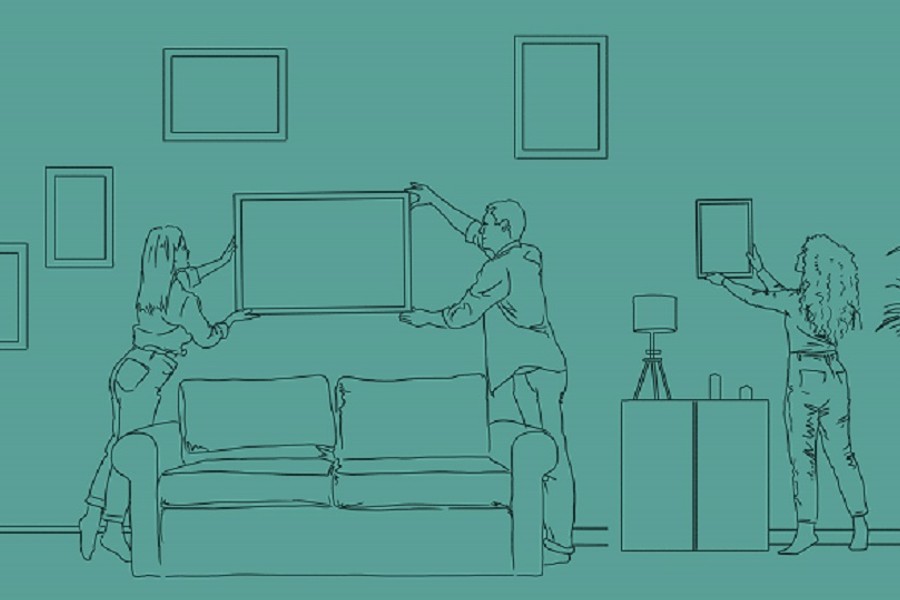We spoke to a range of art experts to get advice on how best to start, grow and develop your art buying skills! Here are their top tips…
1) Do your research
This is the fun part! First of all, you need to ask yourself: What type of art do I like? Abstract or geometric? Print or painting? The answers won’t come from self-reflection alone, so it’s time to branch out and do your research.
Will Ramsay, founder of Affordable Art Fair, says it’s all in the preparation. “Familiarise yourself with local galleries and follow them and their artists on social media. Or, get to know recent graduates - meet them in person, and talk to them about their work. Knowing more about an artist, their inspirations and their story might make the start of an unexpected collecting journey.” He suggests starting a shortlist of all the pieces that catch your eye, and taking lots of photos.
So then it’s time to get out there and see art. Hugo Barclay – Fair Director of Affordable Art Fair, suggests attending exhibitions, galleries, and art fairs so that you can to get a sense of the type of art that resonates with you and help you to learn what your style is: “I recommend getting a group chat together to share upcoming shows you’d like to attend.”
You can also hunt for art from your phone: fill your social feed with artists and galleries to learn about their creative practices and to see their work behind the scenes.
Stylist and art collector Kavita Mehta tends to be more impulsive with her art buying decisions, but her younger self paved the way in terms of research. She used to collect postcards of her favourite artworks from exhibitions and put them all over her walls, which helped her to hone in on the art she liked to put in her home.
2) Buy what you love
All our experts are in perfect unison with this top tip. Don’t buy art for investment - buy art because you love it.
Jennifer Conner, Regional Managing Director of Affordable Art Fair UK says: “Listen to your gut. If you walk away from a work and 10 minutes later start panicking that someone else may get it before you, that’s a sure sign! Always purchase artwork based on your emotional reaction, rather than on what you consider to be its worth. The most valuable works are those that bring you joy every day.” Often, if you need more time to make a decision, galleries will allow you to try out an artwork at home to make sure it’s right for you. This is a key piece of advice to keep in mind while refining your collecting skills.
"Don't limit yourself to one artist! There is great satisfaction in supporting the next generation of artists" Will Ramsay
3) Trust your gut
For Kavita, the decision to buy art is also based on emotions – those unexplainable feelings you have when an artwork speaks to you. She believes it’s essential to trust your gut feeling, because sometimes overthinking an art purchase can rob it of its magic. She really enjoys finding art in immersive environments where there’s so much to see, as it’s a more inspiring way to make decisions, rather than being confronted by stark white walls you need to fill, which can be daunting!
New York-based interior designer Jeanie Engelbach is an advocate for trusting your own style and taste. Especially when attending an art fair, she says “you don’t want indecision to mean that your dream piece goes home with another art lover.” When it comes to finding the ideal place for your artwork at home, Jeanie says: “Art doesn’t have to be stagnant; you can move it around. It will always find a place in your next home. Listen to your gut. It’s always right.”
4) Set a budget
Budgets look different to every collector, so Hugo encourages you to think about what you would feel comfortable spending on an artwork, and how regularly you might like to acquire a new work. Then, try to stick to it. Will says: “If you find something you adore and it’s a little out of budget, ask the gallery if you can pay in interest-free instalments with schemes like Own Art.” These payment plans are a great option and can open up a new price range for you.
"Don’t be intimidated: everyone can enjoy buying and owning art" Will Ramsay
Often, new art buyers begin their collections with limited edition prints, which tend to come in at a more accessible price. This is how Kavita Mehta first began to fill her home, and she still has the same advice today: “If you’re in the early stages of buying art, prints are a great option because they’re affordable.”
5) Ask around
Many people associate art with an elite, expensive world for a select few, but our experts all enjoy buying art in spaces that are inclusive and welcoming - and where they can feel confident in their art buying decisions.
Hearing a narrative behind a piece is Will’s top tip for realising a connection: “Make sure you ask as many questions as you can, to help build your understanding of the art. And always ask for more information on the artworks you like!”
Asking around means building connections, too. After discovering Richard Heeps at Affordable Art Fair New York, Jeanie now owns nine of his artworks and has developed a strong relationship with his gallery, Bleach Box. She can rely on them for advice, inspiration and a friendly face in the often daunting art world. “I’ve been purchasing from Bleach Box for well over a decade now. They’re so easy to work with.”
Hugo’s certain that you’ll never find a gallerist that doesn’t want to share the stories of their artists, so don’t be afraid to ask lots of questions. From the medium and materials, to the artist’s inspiration and their journey into art – the more informed a purchase you make, the more treasured.
Remember that collecting art is a deeply personal and subjective endeavour. It’s about connecting with pieces that speak to you and evoke emotion. Don’t be afraid to take risks, explore new artists and step out of your comfort zone. And most importantly, enjoy the process. Building an art collection is a lifelong pursuit, filled with discovery, growth, and appreciation. So, go forth and curate your own unique art collection, one piece at a time. Happy collecting!



